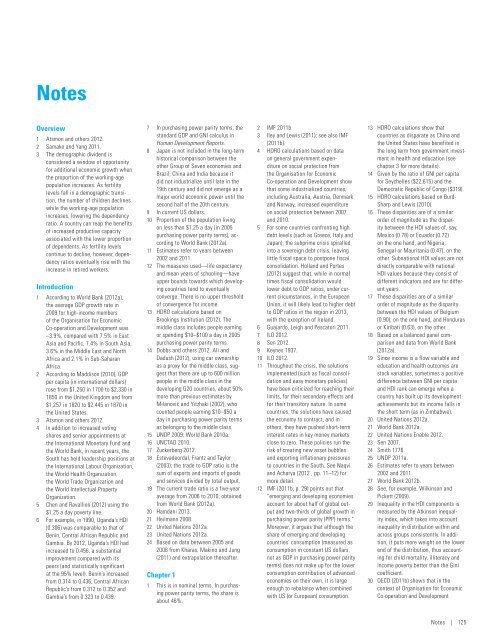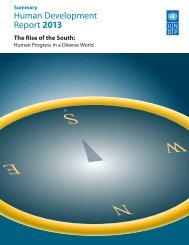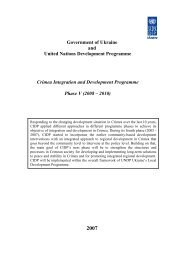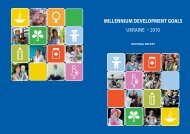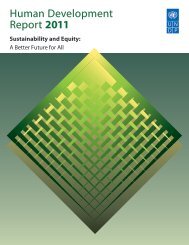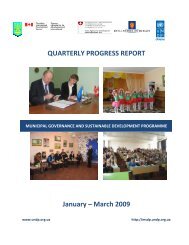E N S W - United Nations Development Programme
E N S W - United Nations Development Programme
E N S W - United Nations Development Programme
You also want an ePaper? Increase the reach of your titles
YUMPU automatically turns print PDFs into web optimized ePapers that Google loves.
Notes<br />
Overview<br />
1 Atsmon and others 2012.<br />
2 Samake and Yang 2011.<br />
3 The demographic dividend is<br />
considered a window of opportunity<br />
for additional economic growth when<br />
the proportion of the working-age<br />
population increases. As fertility<br />
levels fall in a demographic transition,<br />
the number of children declines<br />
while the working-age population<br />
increases, lowering the dependency<br />
ratio. A country can reap the benefits<br />
of increased productive capacity<br />
associated with the lower proportion<br />
of dependents. As fertility levels<br />
continue to decline, however, dependency<br />
ratios eventually rise with the<br />
increase in retired workers.<br />
Introduction<br />
1 According to World Bank (2012a),<br />
the average GDP growth rate in<br />
2009 for high-income members<br />
of the Organisation for Economic<br />
Co-operation and <strong>Development</strong> was<br />
–3.9%, compared with 7.5% in East<br />
Asia and Pacific, 7.4% in South Asia,<br />
3.6% in the Middle East and North<br />
Africa and 2.1% in Sub-Saharan<br />
Africa.<br />
2 According to Maddison (2010), GDP<br />
per capita (in international dollars)<br />
rose from $1,250 in 1700 to $2,330 in<br />
1850 in the <strong>United</strong> Kingdom and from<br />
$1,257 in 1820 to $2,445 in 1870 in<br />
the <strong>United</strong> States.<br />
3 Atsmon and others 2012.<br />
4 In addition to increased voting<br />
shares and senior appointments at<br />
the International Monetary Fund and<br />
the World Bank, in recent years, the<br />
South has held leadership positions at<br />
the International Labour Organization,<br />
the World Health Organization,<br />
the World Trade Organization and<br />
the World Intellectual Property<br />
Organization.<br />
5 Chen and Ravallion (2012) using the<br />
$1.25 a day poverty line.<br />
6 For example, in 1990, Uganda’s HDI<br />
(0.306) was comparable to that of<br />
Benin, Central African Republic and<br />
Gambia. By 2012, Uganda’s HDI had<br />
increased to 0.456, a substantial<br />
improvement compared with its<br />
peers (and statistically significant<br />
at the 95% level). Benin’s increased<br />
from 0.314 to 0.436, Central African<br />
Republic’s from 0.312 to 0.352 and<br />
Gambia’s from 0.323 to 0.439.<br />
7 In purchasing power parity terms, the<br />
standard GDP and GNI calculus in<br />
Human <strong>Development</strong> Reports.<br />
8 Japan is not included in the long-term<br />
historical comparison between the<br />
other Group of Seven economies and<br />
Brazil, China and India because it<br />
did not industrialize until late in the<br />
19th century and did not emerge as a<br />
major world economic power until the<br />
second half of the 20th century.<br />
9 In current US dollars.<br />
10 Proportion of the population living<br />
on less than $1.25 a day (in 2005<br />
purchasing power parity terms), according<br />
to World Bank (2012a).<br />
11 Estimates refer to years between<br />
2002 and 2011.<br />
12 The measures used—life expectancy<br />
and mean years of schooling—have<br />
upper bounds towards which developing<br />
countries tend to eventually<br />
converge. There is no upper threshold<br />
of convergence for income.<br />
13 HDRO calculations based on<br />
Brookings Institution (2012). The<br />
middle class includes people earning<br />
or spending $10–$100 a day in 2005<br />
purchasing power parity terms.<br />
14 Dobbs and others 2012. Ali and<br />
Dadush (2012), using car ownership<br />
as a proxy for the middle class, suggest<br />
that there are up to 600 million<br />
people in the middle class in the<br />
developing G20 countries, about 50%<br />
more than previous estimates by<br />
Milanović and Yitzhaki (2002), who<br />
counted people earning $10–$50 a<br />
day in purchasing power parity terms<br />
as belonging to the middle class.<br />
15 UNDP 2009; World Bank 2010a.<br />
16 UNCTAD 2010.<br />
17 Zuckerberg 2012.<br />
18 Estevadeordal, Frantz and Taylor<br />
(2003); the trade to GDP ratio is the<br />
sum of exports and imports of goods<br />
and services divided by total output.<br />
19 The current trade ratio is a five-year<br />
average from 2006 to 2010, obtained<br />
from World Bank (2012a).<br />
20 Hamdani 2013.<br />
21 Heilmann 2008.<br />
22 <strong>United</strong> <strong>Nations</strong> 2012a.<br />
23 <strong>United</strong> <strong>Nations</strong> 2012a.<br />
24 Based on data between 2005 and<br />
2008 from Kharas, Makino and Jung<br />
(2011) and extrapolation thereafter.<br />
Chapter 1<br />
1 This is in nominal terms. In purchasing<br />
power parity terms, the share is<br />
about 46%.<br />
2 IMF 2011b.<br />
3 Iley and Lewis (2011); see also IMF<br />
(2011b).<br />
4 HDRO calculations based on data<br />
on general government expenditure<br />
on social protection from<br />
the Organisation for Economic<br />
Co-operation and <strong>Development</strong> show<br />
that some industrialized countries,<br />
including Australia, Austria, Denmark<br />
and Norway, increased expenditure<br />
on social protection between 2007<br />
and 2010.<br />
5 For some countries confronting high<br />
debt levels (such as Greece, Italy and<br />
Japan), the subprime crisis spiralled<br />
into a sovereign debt crisis, leaving<br />
little fiscal space to postpone fiscal<br />
consolidation. Holland and Portes<br />
(2012) suggest that, while in normal<br />
times fiscal consolidation would<br />
lower debt to GDP ratios, under current<br />
circumstances, in the European<br />
Union, it will likely lead to higher debt<br />
to GDP ratios in the region in 2013,<br />
with the exception of Ireland.<br />
6 Guajardo, Leigh and Pescatori 2011.<br />
7 ILO 2012.<br />
8 Sen 2012.<br />
9 Keynes 1937.<br />
10 ILO 2012.<br />
11 Throughout the crisis, the solutions<br />
implemented (such as fiscal consolidation<br />
and easy monetary policies)<br />
have been criticized for reaching their<br />
limits, for their secondary effects and<br />
for their transitory nature. In some<br />
countries, the solutions have caused<br />
the economy to contract, and in<br />
others, they have pushed short-term<br />
interest rates in key money markets<br />
close to zero. These policies run the<br />
risk of creating new asset bubbles<br />
and exporting inflationary pressures<br />
to countries in the South. See Naqvi<br />
and Acharya (2012 , pp. 11–12) for<br />
more detail.<br />
12 IMF (2011b, p. 29) points out that<br />
“emerging and developing economies<br />
account for about half of global output<br />
and two-thirds of global growth in<br />
purchasing power parity (PPP) terms.”<br />
Moreover, it argues that although the<br />
share of emerging and developing<br />
countries’ consumption (measured as<br />
consumption in constant US dollars,<br />
not as GDP in purchasing power parity<br />
terms) does not make up for the lower<br />
consumption contribution of advanced<br />
economies on their own, it is large<br />
enough to rebalance when combined<br />
with US (or European) consumption.<br />
13 HDRO calculations show that<br />
countries as disparate as China and<br />
the <strong>United</strong> States have benefited in<br />
the long term from government investment<br />
in health and education (see<br />
chapter 3 for more details).<br />
14 Given by the ratio of GNI per capita<br />
for Seychelles ($22,615) and the<br />
Democratic Republic of Congo ($319).<br />
15 HDRO calculations based on Burd-<br />
Sharp and Lewis (2010).<br />
16 These disparities are of a similar<br />
order of magnitude as the disparity<br />
between the HDI values of, say,<br />
Mexico (0.78) or Ecuador (0.72)<br />
on the one hand, and Nigeria,<br />
Senegal or Mauritania (0.47), on the<br />
other. Subnational HDI values are not<br />
directly comparable with national<br />
HDI values because they consist of<br />
different indicators and are for different<br />
years.<br />
17 These disparities are of a similar<br />
order of magnitude as the disparity<br />
between the HDI values of Belgium<br />
(0.90), on the one hand, and Honduras<br />
or Kiribati (0.63), on the other.<br />
18 Based on a balanced panel comparison<br />
and data from World Bank<br />
(2012a).<br />
19 Since income is a flow variable and<br />
education and health outcomes are<br />
stock variables, sometimes a positive<br />
difference between GNI per capita<br />
and HDI rank can emerge when a<br />
country has built up its development<br />
achievements but its income falls in<br />
the short term (as in Zimbabwe).<br />
20 <strong>United</strong> <strong>Nations</strong> 2012a.<br />
21 World Bank 2012a.<br />
22 <strong>United</strong> <strong>Nations</strong> Enable 2012.<br />
23 Sen 2007.<br />
24 Smith 1776.<br />
25 UNDP 2011a.<br />
26 Estimates refer to years between<br />
2002 and 2011.<br />
27 World Bank 2012b.<br />
28 See, for example, Wilkinson and<br />
Pickett (2009).<br />
29 Inequality in the HDI components is<br />
measured by the Atkinson inequality<br />
index, which takes into account<br />
inequality in distribution within and<br />
across groups consistently. In addition,<br />
it puts more weight on the lower<br />
end of the distribution, thus accounting<br />
for child mortality, illiteracy and<br />
income poverty better than the Gini<br />
coefficient.<br />
30 OECD (2011b) shows that in the<br />
context of Organisation for Economic<br />
Co-operation and <strong>Development</strong><br />
Notes | 125


